CHAPTER 5

Fulfillment Menopause and Beyond
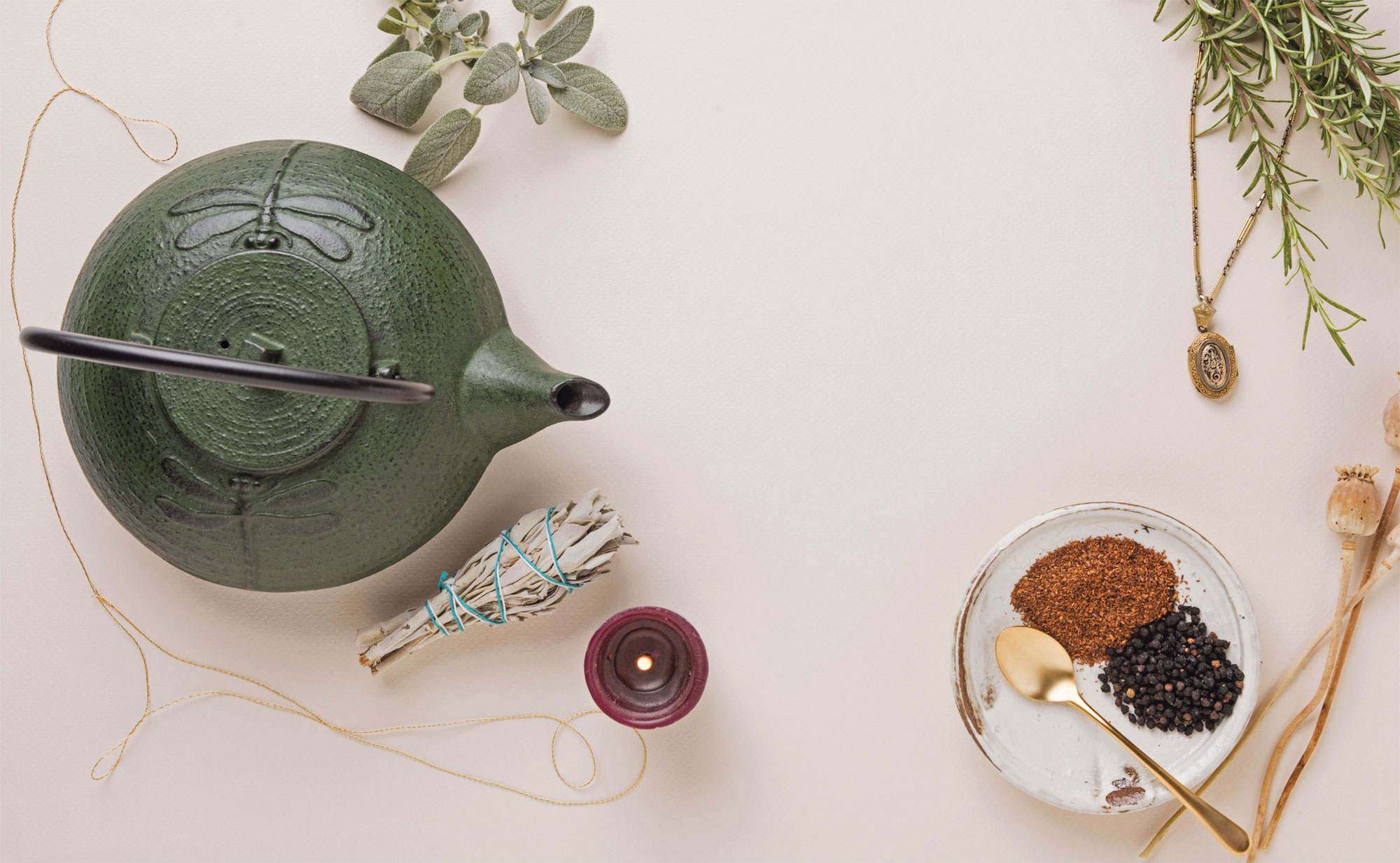
AS I ATTEMPT TO MOVE THROUGH MY FORTIES as gracefully as I can, life never ceases teach me new lessons—or the same old ones over and over. As someone who thrives on personal growth, I welcome these opportunities to learn more about how I walk through the world communicating with myself and engaging others. Sometimes, the lessons are gentle nudges of remembrance; other times, it’s as though I’ve just been run over by a bus. Our physical and emotional experiences shape us as we move through life. They can better us, break us, or sometimes go completely unnoticed. But each time we do notice them, it’s an opportunity to gain another piece of understanding, another piece to fill our basket with fulfillment. I truly used to think that by the time I reached middle age, which begins at age forty-five, I would be at peace with my life and myself. It goes to prove that we never stop learning if we continue to seek out new opportunities and ways in which to grow.
When I was a young herbalist, I was always interested in the female body and the herbs to support it. Perhaps my own body inspired me, as I was often fascinated by everything it could do and how easily it was influenced. I took several concentrated courses in women’s health, allowing me to gain valuable and applicable knowledge. One of the nice things about studying health, and herbal medicine in particular, is its ability to be applied readily. You can find a tea section in almost any grocery store and begin using herbs today if you’d like. That accessibility is immensely valuable to our communities and important for personalized health care.
One area of women’s health that I’ve always been drawn to is menopause. Although our society seems to begin seriously discounting woman as valuable after the age of fifty, I have always found this time in a women’s life to be filled with intention and purpose. Women over fifty tend to have a sense of resolve with themselves and the world around them. They all speak of having a stronger sense of self-confidence and an easier time navigating strife and struggle should it come up in their lives. Naturally, experience plays a part in this, but I’m keen to believe it runs deeper than that. After fifty years of living, I think we all deserve to have respect and peace in our lives. The only way to guarantee that is from within; we can’t always control our finances, health, relationships, jobs, and other external influences. But as we get older, we can look to ourselves to find inner fulfillment. Many years ago, while traveling, I found myself in a poverty-stricken country that offered its citizens little hope of escape. Despite this, I continuously came across older women whose smiles repeatedly met mine. They had little in the way of material wealth, but they spoke to me about how happy and fulfilled they were in their lives. They had family and music, and they were grateful every day. I will never forget how bright their eyes shone when we spoke. It was a clear message that the true path to health and fulfillment began with inner happiness.
The first parts of our lives are extremely outward focused. Going to school, working, and perhaps having children all require an extreme amount of outward energy. Both menstruation and pregnancy are physical and energetic releases out of the body. For thirty-some years, most women menstruate and ride the hormone highway each month. They also pursue education, manifest careers, raise children, support families, and attempt to balance the persistent voices from our media and society telling us we need to do more. Meanwhile, their equal rights, pay, and progression are suppressed. All this needs to be considered when we speak of health and wellness, as it can directly correlate to the state of our well-being.
When we reach perimenopause/menopause, the energy that was once used to conduct the ebb and flow of menstruation ceases. The hormones that have been going up and down for years and years readjust to the new normal of no menstruation. Consider the emotional impact this amazing shift has on women. Some grieving is normal—the grieving for a time past, for birthing no more children, and perhaps fear of the future. Ultimately, the understanding of what it means to radically shift our hormones is of utmost importance and needs to be evaluated.
Hormones in general can affect our mood, our decisions, and how we view the outside world and ourselves. For some, the years of menstruation are a perpetual balance of understanding what is a hormonal response and what is a true interpersonal one. Even though they may all be the latter, hormones can accentuate our truest feelings. When the hormones begin to diminish due to absence of ovulation and menstruation, yet another emotional shift can occur as well. Our body is now utilizing the extra energy in other areas of our body for health and healing, and the lack of hormones, which can cause symptomatic complaints (more on that in a minute), often catapults us into a new emotional paradigm.
As you might guess, the initial drop in hormones can be uncomfortable. Some of my patients report feeling extremely irritable or crazy. When we tease out these statements, it’s obvious that they are not acting like this outright, but that it is more of a constant internal feeling of discomfort. I think we can only expect this to be normal. Your hormones are no longer acting as they have for the past thirty years of your life; your internal systems are shifting, and that’s going to feel quite different. Give the process time, and herbal support, to ease the transition and lessen the possible symptoms of your body’s new way of operating. As herbalist and medical consultant Amanda McQuade Crawford once said, “Changes that accompany menopause are no less dramatic than those we experienced at puberty.”
So that we are all on the same page, let’s talk about menopause. Menopause occurs when the ovaries stop releasing eggs and menstruation ceases. “Pre-menopause” can begin eight to ten years before complete menopause and occurs when the normal monthly cycle of ovulation and menstruation becomes less regular. This entire period of transition is also known as the “climacteric” phase, because the reproductive phase of life is reaching its climax. The widely used term is perimenopause, meaning “the time surrounding menopausal changes.”
Pre-menopause is usually a gradual process, so women may not know exactly when it begins. If women are reasonably healthy and older than thirty-six, an irregular cycle may be a sign of pre-menopause. Pre-menopause commonly begins in the forties, but it can start earlier for various reasons. Genetics, high-stress lifestyles, emotional issues, socioeconomic influences, environmental concerns, and gynecological problems may contribute to early onset of pre-menopause. I recommended talking to your female relatives about cycle patterns as a means to gauge your own. With all our modern influences, things seem to be shifting, but such discussions can still provide helpful information.
Signs and symptoms of menopause include hot flashes, night sweats, insomnia, vaginal dryness, vaginal thinning, vaginal irritation, an inability to climax, decreased libido, and emotional shifts. But at least eight of these nine symptoms can also be caused by other things. Always see your health practitioner of choice to talk through any shift you are experiencing. This can help determine causes you might not have considered. I had a younger patient who was convinced she was beginning perimenopause because she was suddenly experiencing intense night sweats. After a thorough conversation proving perimenopause was unlikely, I asked her about her bedding. She was someone who typically ran cold and had a lot of blankets on her bed. Considering this, and that we had just changed seasons from winter to spring, I asked her to remove one of the blankets from the bed. She e-mailed three days later to report that the night sweats were gone. I’m not downplaying physical symptoms; my point is that discussing your symptoms with someone can sometimes result in simple solutions.
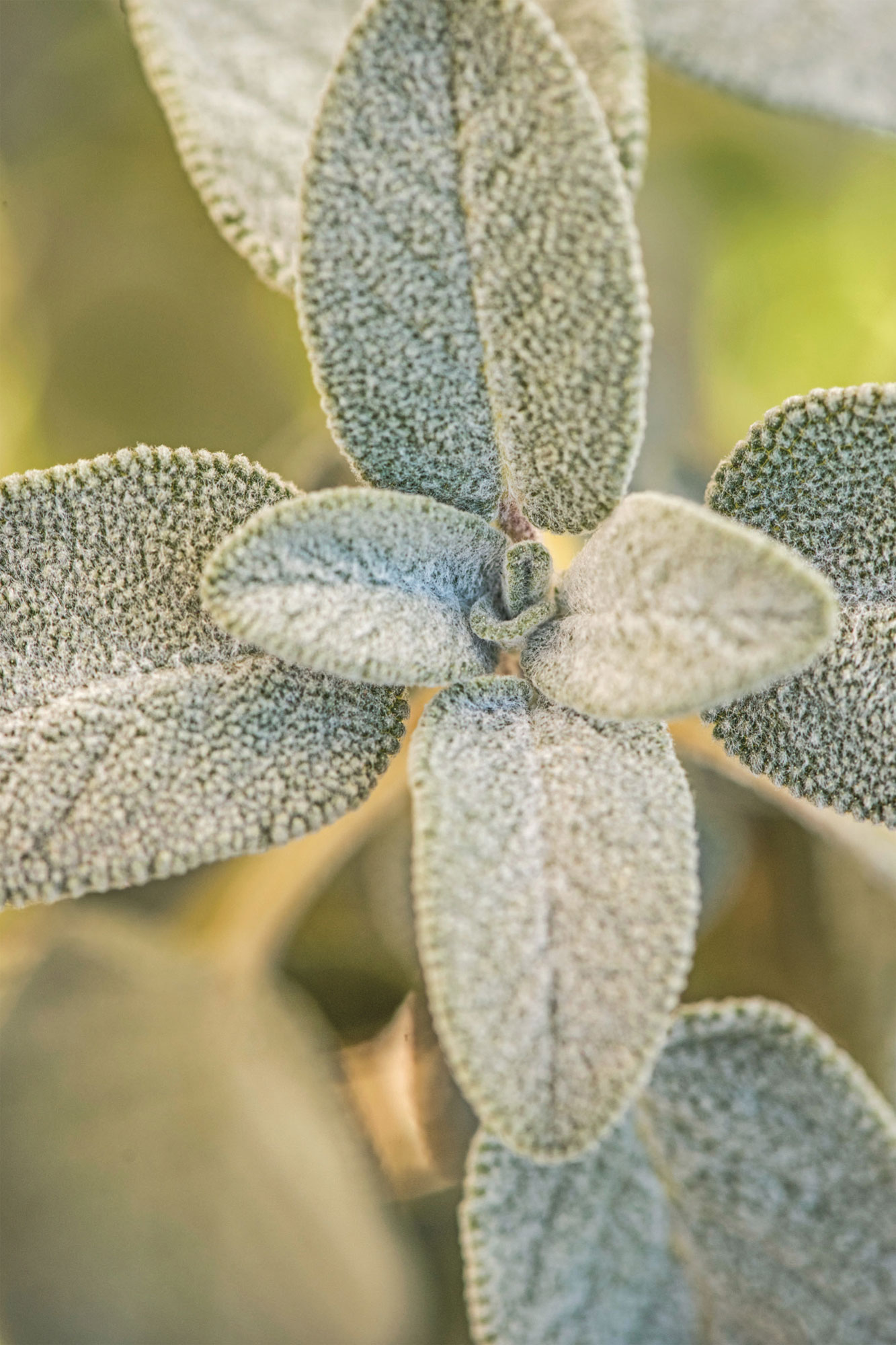
A SHIFT IN THE VAGINA
Two of the most common complaints of perimenopause and menopause are vaginal thinning and dryness. These are most often due to declining estrogen levels. The effects of decreasing estrogen happen over time and vary from woman to woman. Thinning, irritation, and dryness are the results, as well as the labia being reabsorbed over time. Estrogen helps keep the vaginal tissues fat and plump, and with their levels declining, the vagina actually redesigns itself. The labia minora may eventually disappear, and the vaginal canal gets smaller. The vaginal walls become thinner, and the vaginal tissue becomes less cornified, meaning durable and tough. The vaginal canal of a younger woman is all cornified for intercourse purposes. This typically protects the vagina from penetration and friction. When the cornification of the tissue transitions, vaginal tissue can easily be irritated during sex and at times may bleed afterward. During perimenopause and menopause, hormonal imbalance may thin or dry the lining of the vagina, causing it to become inflamed or sensitive. If a woman is experiencing discomfort during sex or the vaginal dryness persists despite normal sexual desire, it may indicate atrophic vaginitis—the term used for chronic vaginal inflammation.
Another anatomical result of decreased estrogen is that the cervix can become shallower, and its size typically decreases.
When a woman has not had a menstrual cycle for twelve consecutive months, she is considered menopausal. The time before that is the perimenopause phase. This is when ovulation and menses become irregular and hormones are attempting to reregulate. Conception is still possible, but the viability of the eggs greatly decreases during this time. As any woman in her forties can tell you, the days of increased vaginal moisture during sex have slowly disappeared. Decreased estrogen leads to the vaginal glands secreting less mucus, which can make sex irritating to the vaginal canal unless lubrication is used or additional foreplay brings about natural lubrication. The woman’s body is fascinating. Although our ability to conceive diminishes and the body reorients itself, the changes aren’t all bad. Read the “Libido” section below to learn how our body’s reproduction focus turns into pleasure focus during the Fulfillment phase.
Herbs have been used for centuries to liberate the stored estrogen of the body. Throughout our lives, certain hormones are metabolized into estrogen for storage in our fat cells. This is yet another way in which the body amazes me. This storage is saved for the Fulfillment phase. The body knows, understands, and prepares for the need of estrogen later in life by storing small amounts in fats cells to be utilized as we enter menopause. It is a lifelong preparation. Once we enter menopause and estrogen production drops, we liberate estrogen from fat cells. It enters the bloodstream and can be utilized.
There are two approaches to using herbs during the Fulfillment phase. One is to support what hormones we already have available to us versus introducing new exogenous forms of hormone replacement. By freeing the stored estrogen from fat, you are giving your body the small increments it needs to maintain physiological balance. Herbs that support the liver can help reduce undesirable symptoms. Herbs that promote progesterone production are valuable for maintaining the balance of the reproductive hormones; this in turn can keep vaginal tissues healthy, reduce vaginal irritation, balance the pH of the vagina, and possibly improve libido. Herbs are also used to reduce or clear the body of the symptoms that can accompany menopause.
Another approach is to use herbs that demonstrate estrogen effects; they’re called estrogenic herbs. To determine if you want to use them, you must understand how these herbs work in the body. Estrogenic herbs are classified as such when they have a high percentage of isoflavones present. Isoflavones, which fall under the flavonoid grouping, can mimic estrogen in the body. When we enter the Fulfillment part of our lives, estrogen is greatly diminished. This dip in estrogen can contribute to menopausal symptoms such as hot flashes, insomnia, vaginal changes, and bone loss. Using estrogenic or phytoestrogen herbs can offer the body micro amounts of estrogen-like substances to reduce the symptoms. Foods containing phytoestrogens include beans, soy products, peas, lentils, and whole grains and seeds, especially flaxseed, rye, and millet. Herbs that contain phytoestrogens include red clover, alfalfa, hops, licorice, thyme, and lemon verbena. Some herbs that mimic phytoestrogens but do not have their true characteristics are black cohosh, dong quai, and ginseng. Research is regularly conducted with phytoestrogens; although concrete stances have not been determined, it is generally believed that phytoestrogens work much differently than naturally produced estrogen in the body. They aren’t considered to lead to estrogen dominance or excess estrogen production. They tend to have selective qualities on receptive sites, working to create balance in the body. We honestly cannot yet say if phytoestrogen herbs should or should not be used if you have an estrogen-driven cancer. One thing we do know is that the abundance of xenoestrogens—chemicals that surround us that mimic estrogen in the body—are a leading cause of hormone disruption and gene expression, leading to disease and chronic pathologies.
When evaluating how to care for the vagina as we enter the Fulfillment part of our life, we must consider stress. Stress at this point in our lives can directly affect the health of the vagina and our libido. It has a way of perpetuating habits that may feel good in the moment but have detrimental effects. These can include excessive sugar, fat, or caffeine intake and a lack of proper hydration. Stress can perpetuate the need to complete one more task in order to feel that it’s safe to relax. Or it can result in a habit of putting everyone else’s needs before your own. Finding regular moments for yourself is vital at this time of your life. Balancing the physical transitions with inner calm can produce powerful shifts toward peace in your daily life.
Reminder: Being and identifying as a woman who possesses a uterus is a blessing, not a curse. If you feel you’ve been moving from one aspect of your life to another with nothing but negative uterine experiences, I wish something better for you. Suffering through menstruation and perhaps reproduction only to move into five to ten years of miserable menopausal symptoms is not a way to live. Let the herbs help. Seek out a new care provider to help you achieve a higher quality of life. You are worth it, and you have too much to offer this world to be sidelined due to hormonal imbalance.
VAGINAL HEALTH
Caring for every part of our body, including our vagina, is important as we age. Caring for the delicate tissues and ensuring proper flora allow us to be comfortable in our body.
Stock your home herbal pantry with the following for vaginal health:
Calendula flower
Chamomile flower
Comfrey leaves
Elderflowers
VAGINAL DRYNESS ESSENTIAL OIL BLEND
Apply twice daily to external vaginal tissue and tissue at introitus. You can use this blend anytime to soothe irritation.
11/2 tablespoons (25 ml) jojoba oil
1 teaspoon (5 ml) vitamin E oil
25 drops helichrysum essential oil
15 drops ylang-ylang essential oil
YIELD: 1 ounce (28 ml)
Combine all ingredients in a 1-ounce (28 ml) bottle. Gently mix.
VAGINAL TISSUE HEALER SALVE
When irritation or bleeding occurs, apply this gentle tissue healer 3 times per day.
1/2 ounce (14 g) dried chamomile flower
1/2 ounce (14 g) dried calendula flower
1/2 ounce (14 g) dried comfrey leaves
1/2 ounce (14 g) dried elderflowers
1 cup (235 ml) olive oil
1 teaspoon (5 ml) vitamin E oil
1 ounce (28 g) beeswax
60 drops rose essential oil
YIELD: 8 ounces (224 g)
Preheat oven to 170°F (77°C). Place herbs in a glass baking dish and cover with olive oil. Bake for 4 hours. Strain. Add the vitamin E oil and then transfer to a saucepan. Heat over low heat while adding the beeswax; stir until completely melted. Remove from the heat and add rose essential oil; pour into container of choice.
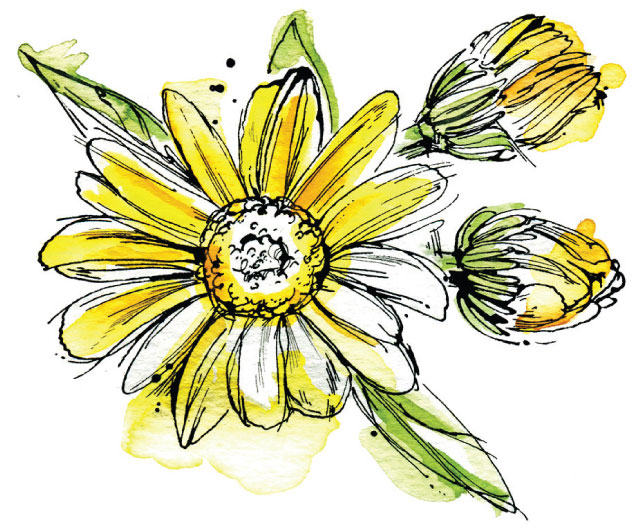
Calendula
HERBAL LUBRICATION
This can be used anytime to soothe dry tissues, but it is also safe to use during sex to lubricate the vagina. There are plenty of essential oils to choose from: Lavender is relaxing, jasmine and ylang-ylang are aphrodisiacs, rose and helichrysum are healing for skin tissues, and peppermint and rosemary give a little spice should you so desire.
1 ounce (28 g) dried comfrey leaf
1 cup (218 g) coconut oil
2 teaspoons (10 ml) aloe vera gel
Essential oils such as lavender, peppermint, rosemary, jasmine, rose, ylang-ylang, or helichrysum (optional)
YIELD: 1 cup (235 ml)
Preheat oven to 170°F (77°C). Place comfrey in a glass baking dish and pour enough coconut oil over it to cover by 1 to 2 inches (3 to 5 cm). Bake for 4 hours. Allow to cool and then strain into a bowl. Add aloe vera gel; mix well. At this point you can add essential oils if you’d like; I’d keep it to around 40 to 60 drops your first round. You can always adjust to your preference with your second batch.
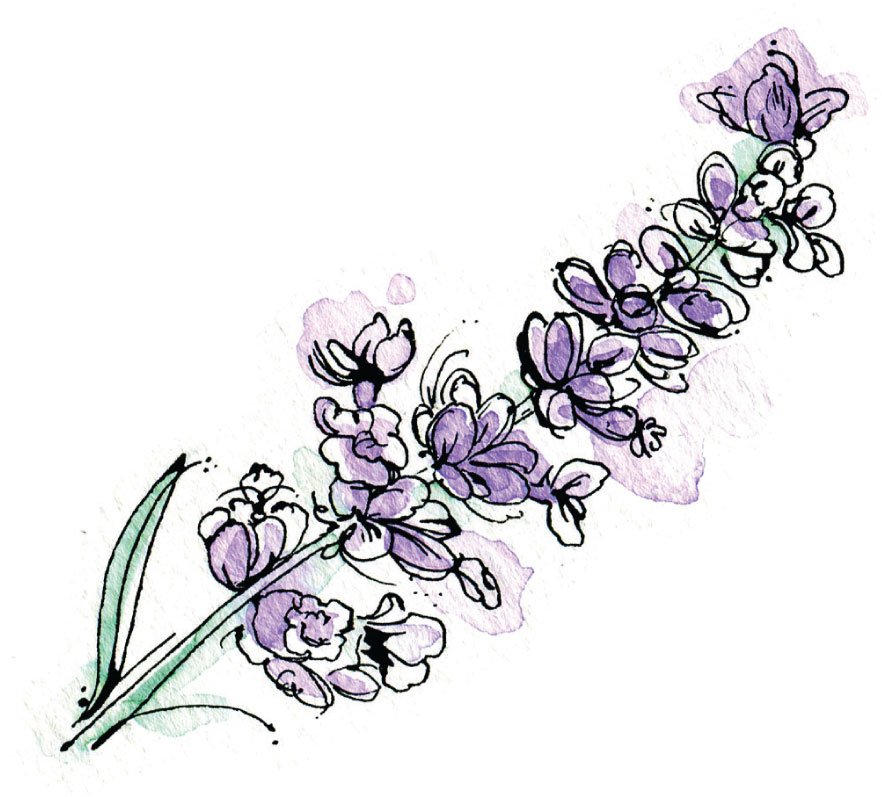
Lavender
LIBIDO
Throughout my years studying menopause, one subject has continually fascinated me: the better orgasm. All we ever hear about in the media is that menopausal women have no sex drive or ability to climax. Well, my studies show differently. Although sexual interest might take some more inspiration, the menopausal vagina is primed and poised for great things. The thinning of the vaginal walls actually accesses nerve endings in a new way, making them more easily excitable. The lack of immediate moisture demands that purposeful and sensual touch be used to elicit excitement. This takes time and allows the body to respond in a slower, but ultimately stronger way. I encourage all my patients, women and men, to utilize this information to engage in new ways to stimulate each other; both will reap the rewards.
Stock your home herbal pantry with the following for libido:
Ashwagandha root
Cardamom
Cinnamon
Damiana leaf
Ginger
Licorice root
Maca root
Nutmeg
Passionflower leaf
Rose petals
Shatavari root
Tribulus
Vanilla bean
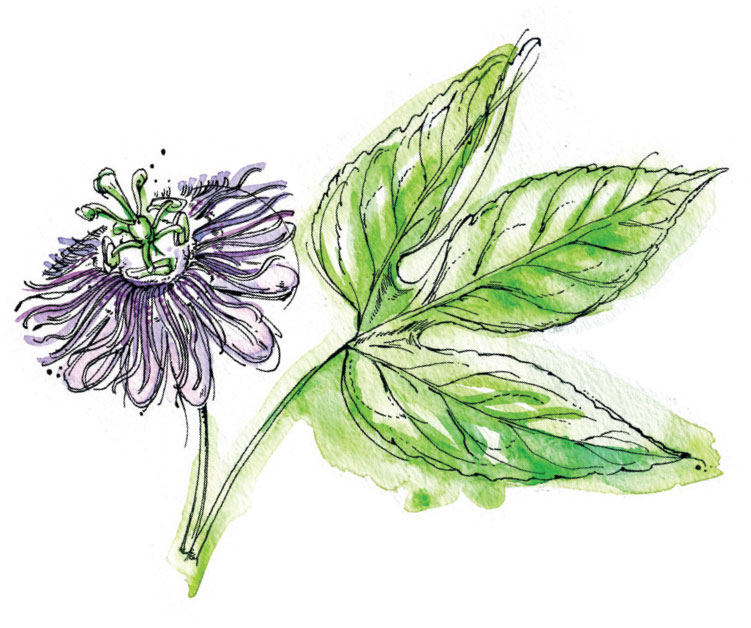
Passionflower
LIBIDO TONIC TEA
As hormones change, so does libido. Using herbs such as maca and tribulus has been known for centuries to improve sex drive by balancing hormones.
11/2 ounces (42 g) shatavari root
1 ounce (28 g) maca root
1 ounce (28 g) tribulus
1/4 ounce (7 g) licorice root
1/4 ounce (7 g) rose petals
YIELD: 4 ounces (112 g)
Combine all ingredients; store in a glass jar. Make medicinal strength (see here), and drink 2 cups daily for 6 to 8 weeks.
IN THE MOOD TINCTURE
When you wish to set the mood, take this an hour beforehand and find that special someone to get close to.
2 teaspoons (10 ml) passionflower leaf tincture
1 teaspoon (5 ml) damiana leaf tincture
1 teaspoon (5 ml) licorice root tincture
1 teaspoon (5 ml) ashwagandha root tincture
1 teaspoon (5 ml) California poppy flower tincture
YIELD: 1 ounce (28 ml)
Combine all extracts in a 1-ounce (28 ml) amber dropper bottle. Take 1 to 2 dropperfuls as needed.
APHRODISIAC ESSENTIAL OIL BLEND
This is a great blend to add to a diffuser in the bedroom. It focuses on relaxation and stimulation of the excitement centers.
1 teaspoon (5 ml) ylang-ylang oil
1/2 teaspoon (2.5 ml) rosewood oil
1/2 teaspoon (2.5 ml) cardamom oil
YIELD: 2 teaspoons (10 ml)
Combine all oils in a 10 ml essential oil bottle. Use 5 drops in a room diffuser as desired.
HERBAL APHRODISIAC CHOCOLATE
Many of our culinary spices have healing potential. Here’s one way to spice up more than the kitchen.
1 cup (218 g) cocoa butter
3/4 cup (255 g) honey
1 cup (86 g) raw cacao powder
1 teaspoon (5 ml) vanilla extract
1 teaspoon (2.3 g) ground cinnamon
1/8 teaspoon ground nutmeg
1/4 teaspoon ground ginger
1/4 teaspoon ground cardamom
1/2 teaspoon vanilla bean powder
Pinch of sea salt
YIELD: 12 balls
In a double boiler, slowly heat cocoa butter over very low heat until melted. Slowly stir in honey until completely mixed. Stir in the remaining ingredients and pour into molds. Chill in the refrigerator for up to 4 weeks. Share 1 to 2 with a lover.
HORMONE REGULATION
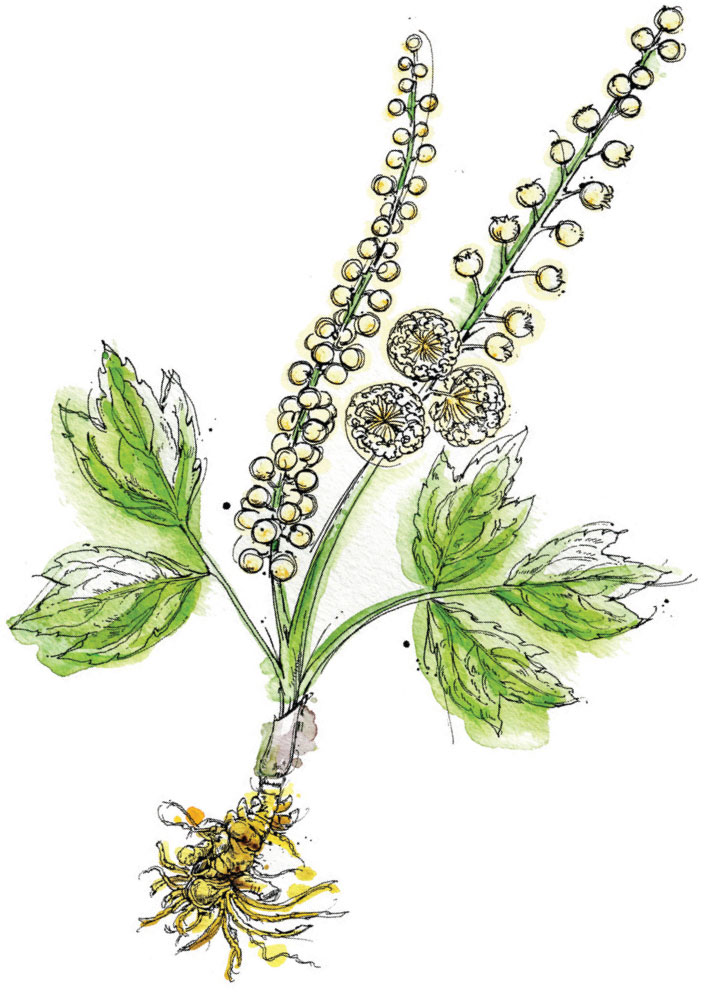
Black Cohosh
When our hormones are transitioning to the menopausal state, they need support to reestablish a new normal. This is a great time for herbal hormonal tonics. These formulas should be used for 8 to 12 weeks to gently work with the body in establishing healthy balance.
Stock your home herbal pantry with the following for hormone regulation:
Black Cohosh
Dong Quai
Eleuthero root
Lemon Balm leaf
Licorice root
Maca root
Nettle leaf
Partridgeberry
Rhodiola root bark
Sage leaf
Spirulina powder
Tribulus
Vitex berry
Yellow Dock root
HORMONE BALANCE TINCTURE
Resetting the hormone balance may take time, but this formula is known to help.
2 teaspoons (10 ml) maca tincture
2 teaspoons (10 ml) tribulus tincture
1 teaspoon (5 ml) dong quai tincture
1/2 teaspoon (2.5 ml) nettle leaf tincture
1/2 teaspoon (2.5 ml) sage leaf tincture
YIELD: 1 ounce (28 ml)
Combine all extracts in a 1-ounce (28 ml) amber dropper bottle. Take 1 dropperful 3 times per day.
HORMONE BALANCE THROUGH THE LIVER
This tincture will help balance your hormones via supporting the liver.
2 teaspoons (10 ml) yellow dock root tincture
1 teaspoon (5 ml) partridgeberry tincture
1 teaspoon (5 ml) black cohosh tincture
1 teaspoon (5 ml) licorice root tincture
1 teaspoon (5 ml) vitex berry tincture
YIELD: 1 ounce (28 ml)
Combine all extracts in a 1-ounce (28 ml) amber dropper bottle. Take 1 dropperful 3 times per day.
ENDOCRINE SUPPORT CAPSULES
This formula is geared toward supporting the overall endocrine system. A vital blend to support every system, it can be used like a daily endocrine herbal vitamin.
1/2 ounce (14 g) spirulina powder
1/2 ounce (14 g) eleuthero root powder
1/2 ounce (14 g) lemon balm leaf powder
1/4 ounce (7 g) vitex berry powder
1/4 ounce (7 g) rhodiola root bark powder
YIELD: 200 capsules
Mix all ingredients in a bowl. Use the mixture to fill empty vegetable capsules. Take 2 capsules once or twice daily.
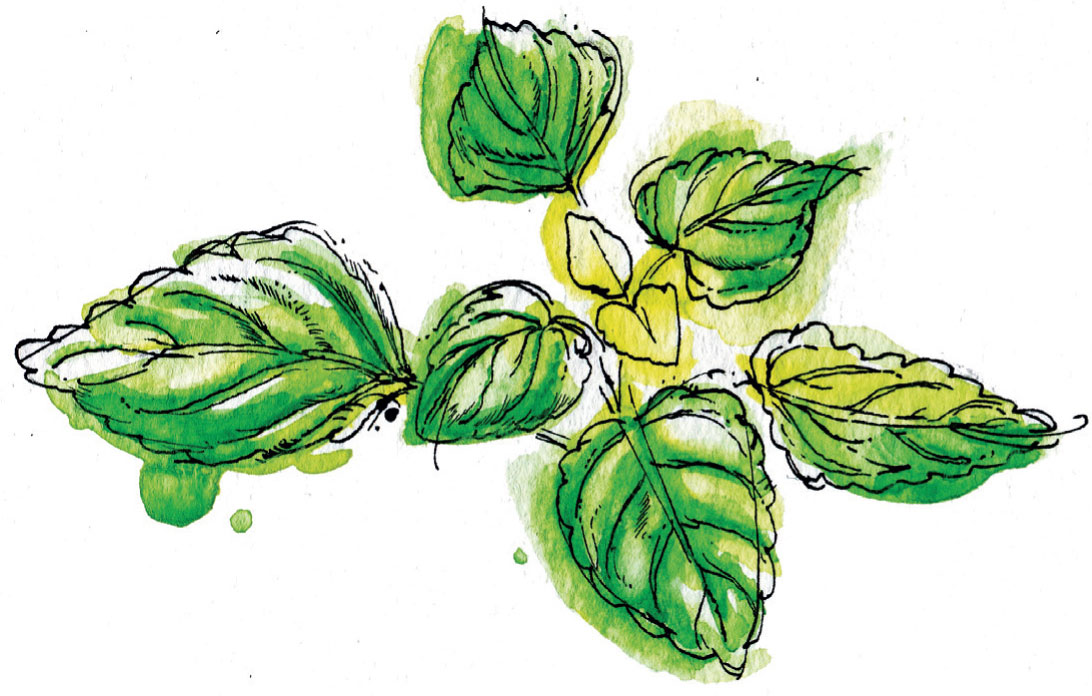
Lemon Balm
BONE HEALTH
As we age, our bones need careful consideration. When we have a decreased output of estrogen, we lose the production of bone osteoblast cells, which stimulate bone growth. As a result, osteoclasts, the cells that absorb bone, end up absorbing more bone than we make. This is why bone-strengthening exercise is so highly valued in later years. You strengthen the bone and also liberate estrogen to support bone growth. Calcium deficiency is also a problem. I wish we could eat our way to calcium balance, but that seems to be proving harder as years go by and our soils become more and more depleted. Although supplemental calcium is helpful, it can be hard to extract from vitamins, making deficiency common. Drinking high calcium teas and herbs that support the hormonal aspect of bone growth are one positive thing you can do.
Stock your home herbal pantry with the following for osteoporosis:
Alfalfa leaf
Black Cohosh root
Chickweed leaf powder
Comfrey leaf
Dandelion leaf
Green tea
Hawthorn berry
Horsetail leaf
Nettle leaf
Peppermint leaf
Rosehip powder
St. John’s Wort
Yellow Dock root powder
OSTEOPOROSIS FIGHTING TEA
This is a daily tonic tea to support the bones through herbal mineralization.
1/2 ounce (14 g) dried nettle leaf
1/2 ounce (14 g) dried alfalfa leaf
1/2 ounce (14 g) dried comfrey leaf
1/2 ounce (14 g) dried horsetail leaf
2 ounces (56 g) peppermint leaf
YIELD: 4 ounces (112 g)
Combine all ingredients; store in a glass jar. Make medicinal strength (see here), and drink 2 cups daily for 8 to 12 weeks.
OSTEOPOROSIS TINCTURE BLEND
This daily tonic tincture supports the bones through herbal mineralization.
2 teaspoons (10 ml) hawthorn berry tincture
1 teaspoon (5 ml) black cohosh root tincture
1 teaspoon (5 ml) St. John’s wort tincture
1 teaspoon (5 ml) nettle leaf tincture
1 teaspoon (5 ml) alfalfa leaf tincture
YIELD: 1 ounce (28 ml)
Combine all extracts in a 1-ounce (28 ml) amber dropper bottle. Take 1 dropperful 3 times per day for 4 to 6 months.
APPLE CIDER VINEGAR OSTEOPOROSIS BLEND
I also recommend making your own herbal vinegars. I used them as salad dressings, or they can be taken the same as the tincture. Using herbal medicine as food is a great way to support the body.
2 tablespoons (9 g) dried hawthorn berry
2 tablespoons (9 g) dried black cohosh root
1 tablespoon (4.5 g) dried St. John’s wort
1 tablespoon (4.5 g) dried nettle leaf
1 tablespoon (4.5 g) dried alfalfa leaf
Apple cider vinegar
YIELD: 1 pint
Put herbs in a pint jar; fill to the top with apple cider vinegar. Close tightly and give it a good shake. Store in a cool dark cupboard for 4 weeks, remembering to shake it every day. Strain the mixture after 4 weeks; use daily.
MINERAL CAPSULES
Trace minerals offer a lot to the body in terms of healing and support. They work on the function and structure of the body in many ways vitamins cannot.
1/2 ounce (14 g) alfalfa leaf powder
1/2 ounce (14 g) yellow dock root powder
1/4 ounce (7 g) dandelion leaf powder
1/4 ounce (7 g) nettle leaf powder
1/4 ounce (7 g) chickweed leaf powder
1/4 ounce (7 g) rosehip powder
YIELD: 200 capsules
Combine all ingredients in a bowl. Use the mixture to fill empty vegetable capsules. Take 2 capsules once or twice daily as a supplement.
Green Tea
Research shows that drinking green tea regularly has positive results in reducing bone density loss. It also shows the reduction in elderly bone fractures in those who drank green tea regularly. Regularly, by the way, would be 5 to 8 cups per week.
HOT FLASHES
Hot flashes are the body’s natural way to control internal temperature. They release internal heat through the skin in an attempt to cool the body off. When they occur at night, they are called night sweats. Unfortunately, we still haven’t nailed down what causes the rise in body temperature that makes the hypothalamus stimulate the brain to release heat in this way, but it is thought to have something to do with the drop in estrogen. Using the hormone balancing recipes listed on pages 165 to 168 may be the ticket to correcting the imbalance, but you can use the following to address the symptoms.
Stock your home herbal pantry with the following for hot flashes:
Black Cohosh
Borage leaf
Bupleurum root
Burdock root
Chamomile flowers
Chickweed
Cleavers
Gingko leaf
Hibiscus
Lavender flowers
Linden leaf and flower
Maca root
Marshmallow root
Peppermint leaf
Rosemary
Sage leaf
Shatavari root
Wild Yam
Yarrow flowers
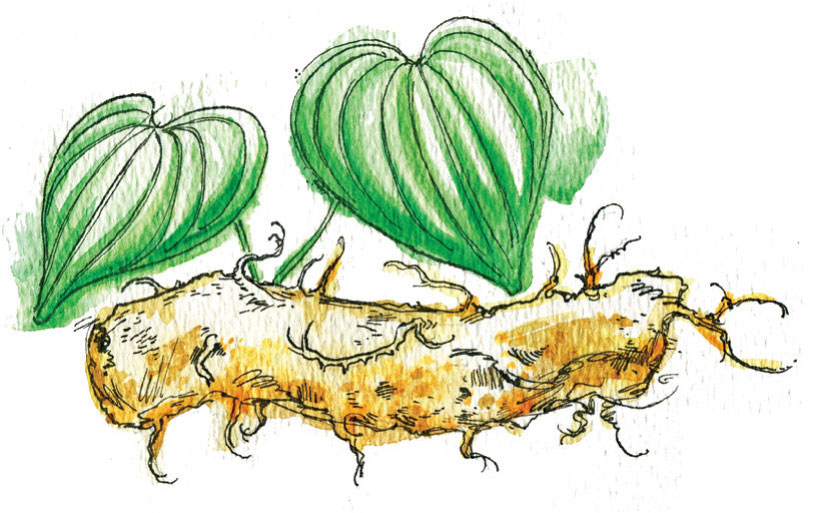
Wild Yam
HOT FLASH TINCTURE
When hot flashes arise, consider using this tonic to shift the patterns, cool down, and redistribute the heat.
21/2 teaspoons (10 ml) black cohosh tincture
2 teaspoons (10 ml) sage leaf tincture
3/4 teaspoon (4 ml) maca root tincture
1/2 teaspoon (2 ml) gingko leaf tincture
1/2 teaspoon (2 ml) shatavari root tincture
YIELD: 1 ounce (28 ml)
Combine all extracts in a 1-ounce (28 ml) amber dropper bottle. Take 1 dropperful 3 times per day.
HOT FLASH ACUTE TEA
This blend is for when you are suffering from acute hot flashes. Take as needed to find temporary relief.
1 ounce (28 g) dried sage leaf
1 ounce (28 g) dried black cohosh
2 ounces (56 g) dried peppermint leaf
YIELD: 4 ounces (112 g)
Combine all herbs and store in a glass jar. Make tea by the cup as needed: Place 2 teaspoons (3 g) of tea in 12 ounces (355 ml) water; simmer, covered, over medium heat for 10 minutes. Turn off the heat and add another 1/2 teaspoon (1 g) tea; cover and let steep for 5 minutes. Or make medicinal strength (see here) to have on hand and drink as needed.
HOT FLASH ACUTE TINCTURE
An alternative to tea, this tincture will also help you when you’re having a hot flash.
11/2 teaspoons (8 ml) sage leaf tincture
11/2 teaspoons (8 ml) bupleurum root tincture
3/4 teaspoon (4 ml) wild yam tincture
3/4 teaspoon (4 ml) black cohosh tincture
11/4 teaspoons (4 ml) peppermint tincture
YIELD: 1 ounce (28 ml)
Combine all ingredients in a 2-ounce (60 ml) amber dropper bottle. Take 1 dropperful 3 times per day as a preventative or take as needed to reduce acute symptoms.
TEA FOR KEEPING IT COOL
Here is another tea option for the summer. Hot flashes or not, this is a great blend to cool down quickly.
1 ounce (28 g) dried hibiscus
1 ounce (28 g) dried marshmallow root
1 ounce (28 g) dried chamomile flowers
1/2 ounce (14 g) dried linden leaf and flower
1/2 ounce (14 g) dried borage leaf
YIELD: 4 ounces (112 g)
Combine all herbs and store in a glass jar. Make tea by the cup as needed: Steep 2 teaspoons (3 g) in 12 ounces (355 ml) of water, covered, for 10 minutes.
COOLING BATH
Sometimes a bath is just what the doctor ordered for a good night’s sleep.
1 ounce (28 g) dried sage
1/2 ounce (14 g) dried rosemary
1/2 ounce (14 g) dried lavender
1/2 ounce (14 g) dried yarrow flowers
YIELD: 1 bath
Fill a large muslin bag with herbs and add it to your bath.
CASTOR OIL FOR HOT FLASHES
On an intuitive hit, I recommended the following castor oil pack to a patient suffering from night sweats. She wasn’t ready to take anything internally but was seeking suggestions. One of castor oil’s greatest gifts is support of the liver. Considering the liver’s relationship to hormones, I thought we’d give it a try. After using it one time, she found relief. In cases like this, I document the success and begin incorporating it with other patients. It has proven its value repeatedly.
1/2 ounce (14 g) dried chickweed
1/2 ounce (14 g) dried cleavers
1/2 ounce (14 g) dried burdock root
1/2 ounce (14 g) dried sage leaf
Castor oil
YIELD: 2 cups (475 ml)
Preheat oven to 170°F (77°C). Place herbs in a glass baking dish and pour enough castor oil over them to cover by 1 to 2 inches (3 to 5 cm). Bake for 4 hours. Allow to cool and then strain the mixture into a storage container. Apply 1 to 2 tablespoons (15 to 30 ml) over your entire abdomen. You don’t need to rub it in. Place a cotton flannel over your abdomen and apply gentle heat from a heating pad or hot water bottle. Relax and rest for 30 minutes. Or go to bed and simply throw the flannel or hot water bottle on the floor at some point during the night.
Note: Be sure your bedding is weather appropriate. I love a down comforter as much as the next gal, but ensure that it’s not making you too hot, exacerbating your night sweats.
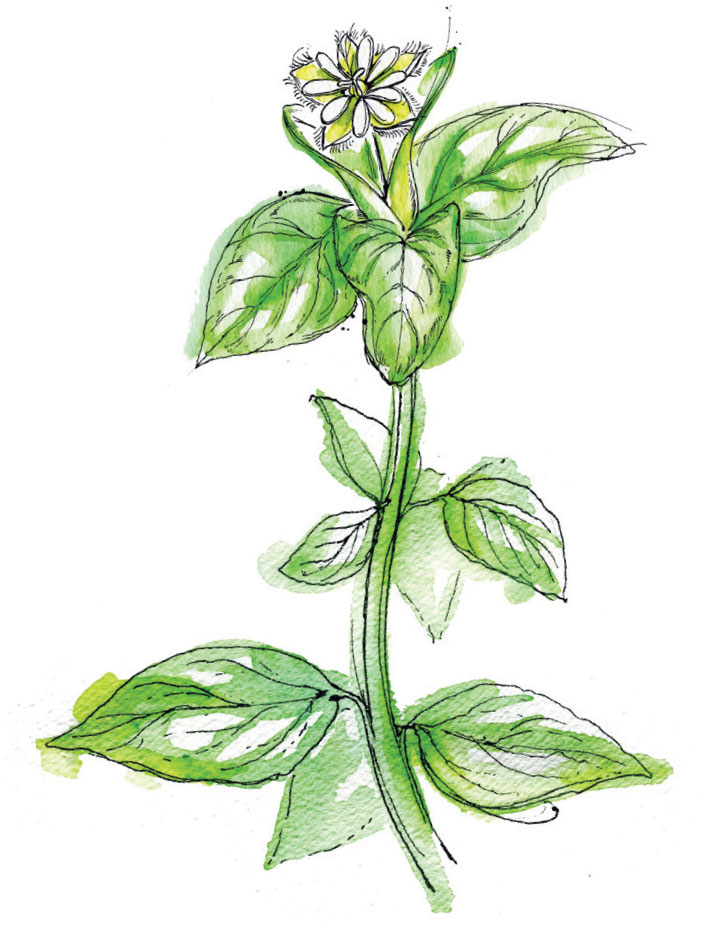
Chickweed
SLEEP AND STRESS
Once again, we return to the adrenals when considering menopause symptoms. In reviewing our adrenal health, we need to ask ourselves how much stress we carry day to day. And if we do have a certain amount of stress, how is it manifesting in our body? In our relationships? What physical complaints are we experiencing, and which of them could be attributed to adrenal insufficiency? My patients are often surprised at the list of complaints that is revealed, as they’ve suppressed the acknowledgment of the symptom for so long. They’ve simply learned to live with it. Stress takes many forms, both physical and emotional, and treating it will bring a sense of well-being back faster than almost anything I’ve seen. Refer to chapter 7 for guidance on supporting the stress centers of the body: the adrenal glands and the central nervous system.
Stock your home herbal pantry with the following for sleep and stress:
Angelica root
Chamomile flower
Chickweed
Eleuthero root
Hawthorn leaf and flower
Hops
Lemon Balm
Sage leaf
Skullcap
Spirulina
St. John’s Wort
Turmeric root
Wild Yam root
Wood Betony
Mediation
I won’t claim to be a regular meditator, but research has repeatedly shown the advantages of meditation and stress reduction.
CENTERING TEA
This tea is recommended for moments when you need to calm and center yourself. Taking 10 minutes to make and drink a cup of tea can reframe your day.
1 ounce (28 g) dried lemon balm
1/2 ounce (14 g) dried chamomile flower
1/2 ounce (14 g) dried wood betony
1/4 ounce (7 g) dried St. John’s wort
1/4 ounce (7 g) dried angelica root
YIELD: 2 ounces (56 g)
Combine all herbs; store in a glass jar. Make tea by the cup as needed: Steep 2 teaspoons (3 g) in 12 ounces (355 ml) boiling water, covered, for 10 minutes.
STABLE MENOPAUSE MOOD CAPSULES
This formula isn’t happy juice in a pill, but it’s directed to balance the internal forces (such as fire and water) that are often in transition during Fulfillment.
1 ounce (28 g) wild yam root powder
1/2 ounce (14 g) eleuthero root powder
1/4 ounce (7 g) turmeric root powder
1/4 ounce (7 g) spirulina powder
YIELD: 200 capsules
Combine all ingredients in a bowl. Use the mixture to fill empty vegetable capsules. Take 2 capsules twice daily.
COOL DOWN AND SLEEP TINCTURE
I typically recommend a tincture for nighttime waking, as the goal is to try to cling to any shred of sleep state versus waking up fully. A tincture is easy to keep next to the bed and take when half awake. Don’t turn on a light; don’t even open your eyes. Simply pick up the bottle, put 2 dropperfuls under your tongue, and lie back down.
1 tablespoon (15 ml) hops tincture
1 teaspoon (5 ml) skullcap tincture
3/4 teaspoon (4 ml) chickweed tincture
1/2 teaspoon (3 ml) hawthorn leaf and flower tincture
1/2 teaspoon (3 ml) sage tincture
YIELD: 1 ounce (28 ml)
Combine all ingredients in a 1-ounce (28 ml) amber dropper bottle. Take 2 dropperfuls as needed.
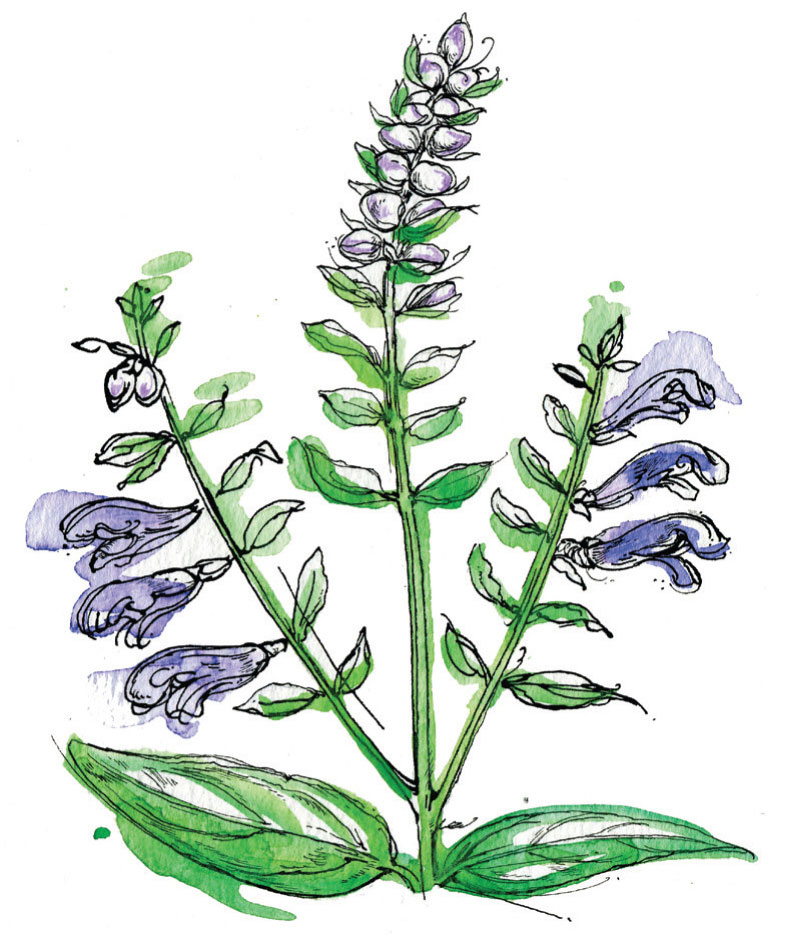
Skullcap
BRAIN SUPPORT
They say pregnancy brain is the worst, but I think anytime you have sudden dips and changes in hormones can challenge the thought processes. When it happens later in life, you can’t help but wonder if it’s the beginning of the end. Rest assured, it is not; it’s just those lovely hormones forcing us to function differently. Here are some other questions to ask ourselves if the think tank isn’t churning as well as it used to: Has my daily movement decreased? Is my circulation feeling strong? Am I eating enough? Am I getting enough sleep? Am I drinking enough water? These can all play a role in brain function and are worth giving attention to if needed.
Stock your home herbal pantry with the following for brain support:
Cayenne
Dandelion root
Ginkgo leaf
Gotu Kola leaf
Hawthorn leaf and flower
Licorice root
Linden leaf and flower
Lobelia leaf
Nettle leaf
Rooibos
Rosemary leaf
Sage leaf
Skullcap leaf
Spirulina
Turmeric root
MEMORY TEA
This tea is a blend of herbs that all focus on mental acuity and clarity. Drink it as often as you’d like or before a work session to get your brain turned on.
1/2 ounce (14 g) dried gotu kola leaf
1/2 ounce (14 g) dried skullcap leaf
1/2 ounce (14 g) dried linden leaf and flower
1/2 ounce (14 g) dried rosemary leaf
1/2 ounce (14 g) dried sage leaf
11/2 ounces (42 g) dried rooibos tea
YIELD: 4 ounces (112 g)
Combine all herbs; store in a glass jar. Make tea by the cup as needed: Steep 2 teaspoons (3 g) in 12 ounces (355 ml) of boiling water, covered, for 10 minutes.
BRAIN BOOST CAPSULES
I’m a big believer in doing daily crossword puzzles to keep your brain sharp, but because I still have to Google the answers most of the time, I use these capsules daily to boost my brain’s thinking power.
1 ounce (28 g) ginkgo leaf powder
1/2 ounce (14 g) rosemary leaf powder
1/2 ounce (14 g) turmeric root powder
1/4 teaspoon ground cayenne pepper
YIELD: 200 capsules
Combine all ingredients in a bowl. Use mixture to fill empty vegetable capsules. Take 2 capsules twice daily.
Note: Due to the cayenne, it is best to wear gloves to make these capsules.
BRAIN ALIVE TINCTURE
This is a great daily-use tincture to support your brain and circulation.
11/2 teaspoons (8 ml) turmeric root tincture
11/2 teaspoons (8 ml) spirulina tincture
11/2 teaspoons (8 ml) hawthorn leaf and flower tincture
1/2 teaspoon (3 ml) dandelion root tincture
1/2 teaspoon (3 ml) nettle leaf tincture
30 drops lobelia tincture
YIELD: 1 ounce (28 ml)
Combine all ingredients in a 1-ounce (28 ml) amber dropper bottle. Take 1 dropperful 3 times per day.
THINK FAST! TINCTURE
We all have those days when our brain just isn’t keeping up with us. Use this tincture as needed to jumpstart the brain back into action.
2 teaspoons (10 ml) rosemary tincture
11/2 teaspoons (7 ml) licorice root tincture
11/4 teaspoons (6 ml) ginkgo leaf tincture
11/4 teaspoons (6 ml) nettle leaf tincture
1/4 teaspoon (1 ml) Cayenne tincture
YIELD: 1 ounce (28 ml)
Combine all ingredients in a 1-ounce (28 ml) amber dropper bottle. Take 1 dropperful 3 times per day, as needed.
THINNING HAIR
Although losing hair is normal at different times of our lives, it’s never comfortable for those experiencing it. Get a physical and consider asking your health care provider to check your thyroid to ensure you don’t miss an overt cause of the problem. Boosting trace minerals, scalp massage, and reducing stress are all key to treatment.
Stock your home herbal pantry with the following for thinning hair:
Ginkgo leaf
Green tea
Horsetail
Kelp
Nettle leaf
Reishi mushroom
Rosemary leaf
Schizandra berry
Spirulina
VITAL GREENS CAPSULES
Packed with vitamins and minerals, this blend supports the body on almost every level. When you offer the body an abundance of nutrition, the hair benefits.
1/2 ounce (14 g) spirulina powder
1/2 ounce (14 g) schizandra berry powder
1/4 ounce (7 g) horsetail powder
1/4 ounce (7 g) nettle leaf powder
1/4 ounce (7 g) kelp powder
1/4 ounce (7 g) reishi mushroom powder
YIELD: 200 capsules
Combine all ingredients in a bowl. Use the mixture to fill empty vegetable capsules. Take 2 capsules twice daily for 6 to 8 weeks.
SCALP MASSAGE OIL
They say rubbing the scalp stimulates the hair follicles to grow. Put some oil onto your scalp and look at yourself in the mirror. Massage the oil down to the scalp and move the scalp back and forth and side to side for 5 minutes a day.
1/2 ounce (14 g) dried Rosemary leaf
1/2 ounce (14 g) dried nettle leaf
1/2 ounce (14 g) dried green tea
1/2 ounce (14 g) dried ginkgo
Olive oil
YIELD: 1 to 11/2 cups (235 to 355 ml)
Preheat oven to 170°F (77°C). Place herbs in a glass baking dish and pour enough olive oil over them to cover by 1 to 2 inches (3 to 5 cm). Bake for 4 hours. Allow oil to cool and then strain into a squeeze bottle for easy application. Squirt close to the scalp over the entire head. Massage for 15 minutes; better yet, get someone else to massage it for you. Apply 3 to 4 times per week.
PROLAPSE
Whether it’s in the bladder or uterus, the feeling of prolapse is one of a deep dragging weight in the lower abdomen. As we age, or after pregnancy, our ligaments tend to stretch and no longer support our structures as they once did. Ligaments are difficult to nourish, as they do not have a direct blood supply to feed them. They are dependent on fluids washing over them to give them what they need to uphold their integrity. Uterus and bladder ligaments are also dependent on estrogen to stay strong. Uterine prolapse is when the uterus drops into the vaginal canal; bladder prolapse is when the bladder drops into the vaginal canal.
PROLAPSE TINCTURE
This formula can be used for either the uterus or the bladder to support and tone the ligaments.
1 tablespoon (15 ml) uva ursi leaf tincture
1 tablespoon (15 ml) red raspberry leaf tincture
2 teaspoons (10 ml) horse chestnut tincture
2 teaspoons (10 ml) dandelion root tincture
2 teaspoons (10 ml) horsetail leaf tincture
YIELD: 2 ounces (60 ml)
Combine all ingredients in a 2-ounce (60 ml) amber dropper bottle. Take 1 dropperful 3 times per day for 8 weeks.
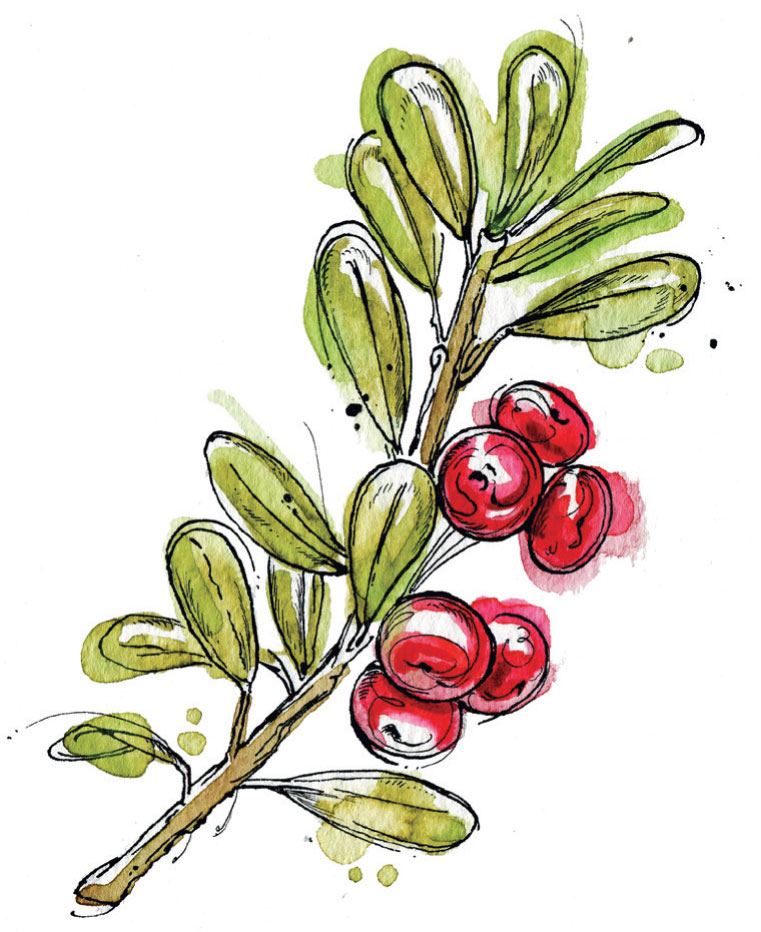
Uva Ursi
CASTOR OIL TREATMENT FOR PROLAPSE
Treatment from the outside in is a good idea when trying to support core supportive structures of the body.
2 tablespoons (18 g) cracked horse chestnuts
2 tablespoons (28 g) comfrey leaf
1 tablespoon (9 g) red raspberry leaf
1 to 11/2 cups (235 to 355 ml) castor oil
YIELD: 1 cup (235 ml)
Preheat oven to 170°F (77°C). Place herbs in a glass baking dish and pour enough castor oil over them to cover by 1 to 2 inches (3 to 5 cm). Bake for 6 hours. Allow to cool and then strain the mixture into a storage container. Rub 2 to 3 teaspoons (10 to 15 ml) over the lower abdomen daily for 8 to 12 weeks.
Dr. Christopher recommends using a douche of equal parts chaparral, elderflowers, and peppermint leaf. I would also recommend seeking out a Mayan abdominal practitioner for an abdominal treatment. Pelvic floor work would also be advised. Just like at any time of your life, caring for your body takes energy and dedication.
When we get older, it becomes more apparent when we don’t take care of ourselves. Our physical ability to compensate for the errors of our ways—rich foods, lack of exercise and water, and increased stress—has been diminished. But this also can be one of the best times of any women’s life, should you choose it. Self-care through balanced nutrition, herbal medicine, body movement, and positive thinking will have powerful effects and create the best you. Feeling good on the inside makes you glow on the outside.
